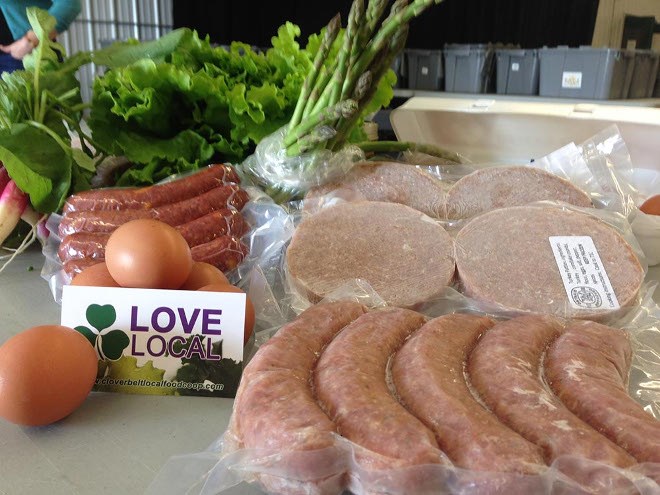The social and economic benefits of growing and buying local food continues to be the mission of Cloverbelt Local Food Co-operative.
The popular and award-winning Dryden-based co-op is in the process of developing a food charter for the Kenora and Rainy River Districts.
With the help of a $65,000 grant from the provincial Greenbelt Fund, four part-time coordinators were hired to help facilitate that beginning in April.
The not-for-profit group boasts a growing stable of 130 producers and 1,400 members.
Producers list online what’s in stock and members log in to make their orders. Food baskets are dropped off weekly at distribution depots in Dryden, Sioux Lookout, Ignace, Upsala and Kenora.
Very shortly, the network will be expanding to the Rainy River district and Thunder Bay, which has a food charter.
The northwest charter is meant to support the advancement of policies to back local food projects.
The initial plan was to establish a food charter for Dryden but interest came from other communities like Kenora to be included, according to Cloverbelt president Jen Springett.
“With everything happening in Sioux Lookout with the regional food distribution centre project (to serve remote First Nation communities) and a lot of farming in Rainy River, we reached out to those communities to be included,” said Springett.
“We recognize rural communities have different needs than the city. We’re more remote with smaller towns and to undertake a charter on our own is not very realistic. We thought a collaborative approach would be most beneficial.”
The food charter not only educates and increases awareness of locally-grown and produced food, but should boost Cloverbelt’s membership and is a good way for Cloverbelt to gather some ground-level intelligence on what are the needs, priorities and visions of local food in these rural communities.
That way, Springett said, Cloverbelt can shape its activities to best align with everyone’s interests.
Springett said some enthusiastic regional development officers in these districts view this kind of collaboration as an exciting opportunity to see what can be accomplished in the agricultural sector.
Despite the 2016 closure of the Clover Valley Farmers’ Market in Fort Frances, Springett said there remains significant interest among local farmers to reconnect to that lost consumer base.
It’s particularly impacted the Rainy River District Regional Abattoir, which is operating at 25 per cent capacity, said Springett.
“That’s a scary situation because if that infrastructure is lost it’s going to have a very detrimental impact on local food in that community.”
Adopting a food charter in that district makes a statement toward protecting and supporting that asset to make it more economically viable, she said.
Another objective behind the charter is to increase local food inclusion in institutions like hospitals and school boards.
But there remain constant challenges in the northwest, specifically related to the distances between the farmers and the communities to transport goods.
As the co-operative continues to scale up, many of these mostly small-scale operations need to develop the capacity to meet that demand, especially for institutional customers.
“We may have to draw from producers in a couple of different communities, which makes transportation even more necessary,” said Springett.
For those procuring food, sometimes there is perceived safety risk by institutions and restaurants to source local food, which she attributes to often a lack of education and understanding.
“The people doing the sourcing may feel that they need to see some kind of certification even though they may not know what that certification is.”
Some certifications that are applicable for large-scale operations are not feasibility and obtainable for small family farms.
“It means that you’re inadvertently excluding local food from the picture.”
Springett said they need to find some level of assurance that doesn’t impose barriers on permitting small-scale operations from participating in these procurement processes.
The Northwestern Health Unit’s has introduced a checklist inspection used in student nutrition programs that could be applicable to provide food safety assurance to restaurants and hospitals looking to participate with small farm operations, she said.
Much of the spade work that Cloverbelt has accomplished over the years in identifying who grows what and where dovetails nicely with Springett’s other job as the northwest coordinator for Local Food and Farm Co-ops, an Ontario-wide advocacy group in support of a sustainable food network.
The group launched its Northern Trade Route project in December with the intent of increasing the trade of local food across the province, particularly Northern Ontario.
The three-year research project involves identifying what producers are transporting food across the northwest and to pinpoint potential funding opportunities to enhance that or build cohesiveness for greater movement of food, said Springett.
“We’re assessing the landscape and seeing where those opportunities lie at the moment.”




